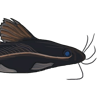Limbu, J.H., Rajbanshi, D., Hu, J., Khanal, L. and Li, C., 2025. Resolving taxonomic uncertainties in ailiid catfishes (Siluriformes: Ailiidae) using Genome-Scale data. Molecular Phylogenetics and Evolution, p.108384.
https://doi.org/10.1016/j.ympev.2025.108384
https://www.sciencedirect.com/science/a ... 0325001010
HighlightsAbstract
- First robust Ailiidae phylogeny using 4,434 nuclear loci (gene-capture).
- Monophyly of six genera (Ailia, Ailiichthys, Clupisoma, Eutropiichthys, Silonia, and Laides).
- and C. sinense reclassified to Laides.
- Eutropiichthys and Silonia formally retained within Ailiidae as distinct lineages.
The family, endemic to South and Southeast Asia, comprises diverse freshwater catfish inhabiting major river basins across the region. Evolutionary relationships and taxonomic classification within Ailiidae family remain contentious. Here, we resolve these uncertainties using phylogenomic data from 29 specimens representing 11 species and six of the seven recognized genera, supplemented by two outgroup taxa ( and P. acutirostris). Hybridization target enrichment and high-throughput sequencing yielded 4,434 single-copy nuclear coding loci. After trimming loci with more than 50 % missing taxa, 2,102 loci, totaling 505,110 bp, were used for phylogenomic analyses. The results confirm monophyly of all studied genera (, , , , and ), after the reclassification of and C. sinense into the genus Laides, based on concordant molecular, morphological and meristic evidence. Notably, and formed an early diverging clade, sister to remaining Ailiidae. Furthermore, our results corroborate that the genera Eutropiichthys and Silonia represent distinct lineages within Ailiidae, warranting their formal retention in the family. Divergence dating estimated the most recent common ancestor of Ailiidae arose during the Pleistocene, with a median age of 2.1 million years ago (95 % HPD: 3.34–1.0 Ma). Biogeographic reconstructions identified the Ganges–Brahmaputra River basin (South Asia) as the center of origin for Ailiidae, followed by dispersal to the Irrawaddy–Salween, Pahang and Indus River basins. Pleistocene climatic fluctuations, tectonic uplift and changes in sea-level may have influenced the dispersal of Ailiidae catfishes. These geological events restructured river systems and exposed land bridges, allowing movement across previously isolated basins. Paleo-river connections between the major drainages of South and Southeast Asian likely facilitated multiple events of vicariance and dispersal, driving diversification within the Ailiidae.
















